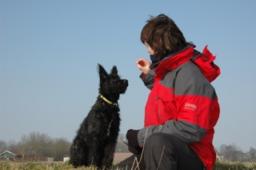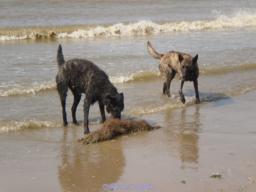|
|
Articles The Dutch Shepherd Dog, the world's least known centenarian? | 
This article was published in 1998 in the British magazine: Dogworld.
Author: Nellie Nugteren
Photograph: Mrs. T. Ringnalda met haar rough haired pup Silke Ruigjekker
There are many ancient, long-established breeds in the world. Many of them owe their fame to the glamour of their looks, the high profile of their owners, or the fact that they captured artist's imaginations and were portrayed alongside their masters. Captured for all eternity on canvas, or in legends and stories, they have become immortal. Their surroundings glorious, their deeds legendary, man has worked to keep these breeds alive.
Let us now take you back to The Netherlands, some time before the 20th century. The countryside still boasts moors and an abundance of small farms. Agriculture abounds. In order to fertilise the land, the farmers kept sheep, which grazed on the moors. Early morning could see a shepherd collect sheep from the various farms that employed him. Each farm would turn out its own flock, to be added to the collective. The shepherd was entrusted with their care during the day and returned the sheep to their respective owners in the evening. In order to do this work properly, good dogs, which were versatile, accompanied the shepherd. The dogs needed to be able to herd, goad and guard, and even if necessary defend the flock from predators. They needed to be sturdy, hardy, obedient yet independent and most of all; they needed to be reliable.
Picture if you will, a medium sized dog, fiercely loyal to its pack, highly intelligent and independent, yet totally trustworthy and reliable. It's coat black with streaks of grey or gold, big enough to ward off any predators, yet light enough to be carried on the shepherd's shoulders if necessary. Hardy and weatherproof, erect ears, intelligent, alert eyes.
This was a true working dog, on which the shepherd relied for his livelihood, his safety and companionship.
The origins of the breed that is known today as the Dutch Shepherd Dog can be found in its suitability for this type of work. Suitability bred conformity, and soon the shepherds on the Dutch moors were working with dogs that not only had the same skills, but also shared a common look.
At the end of the 19th century the country was in the grips of industrialisation. Chemical fertilisers were used more and more, and development of moors and replanting of forest grounds were the order of the day. Sheep, shepherds and their dogs almost all disappeared, they were no longer necessary.
Fortunately this was not the end of the Dutch Shepherd Dog. With the advent of more prosperity, more people could afford to keep a dog for the love of the dog, instead of only for work.
Fearful that the breed would die out with the last of the shepherds, a group of enthusiasts came together and set up the first Breedclub for a Dutch breed. On June 12th, 1898, the Nederlandse Herdershonden Club became a fact and the first Standard of Points was laid down. Thanks to these enthusiasts, the breed is still alive today.
A true working dog
True to its origins, the Dutch Shepherd Dog (or Dutchie, as it is affectionately known to owners and enthusiasts alike) has established itself alongside such well-known working breeds as the German Shepherd Dog and the Belgian Shepherd Dog. The Dutchie can be found herding sheep, guarding home and hearth, in rescue work, police work and as drugs detection dogs in international ports and airports. Several Dutchies have become renowned for their prowess and ability. "Heer Zwier van't Vrijbuitersnest" has returned to the dog's original occupation and works as a sheep-herding dog in Hoog-Buurlo. "Ellerd Azoer van Hollands Gasthuis" was active as rescue dog and was one of the dogs that were successfully employed in Armenia after the 1989 earthquake. "Artessa van Diepenalm" (affectionately known as Tess) is the bane of drug smugglers, as she works with her owner W. Sipman as narcotics dog for the Dutch Customs department. She even carries her own identity card with pawprint!
Development of the breed
After the Nederlandse Herdershonden Club was set up in 1898, the breed became "official". The oldest known Dutch Shepherd Dog that was entered into the Studbook was born in 1896. The NHC set itself the task of structuring breeding activities. Before the advent of the breedclub, the dogs were bred solely for their working capacities. And although the breed had evolved into a type on its own, there were no strict rules regarding type. Over the years the standard of points as first established has changed several times. These changes in the standard however, only served to refine what was already a known and established type. Such changes included the inclusion of too much white as a fault and the allowance for a gradual increase in the size of the breed. However, as photographs from the end of the last century and today will show, the type was already well established and has changed so little that it is often only the quality of the photograph that gives away the fact that it is over 100 years old. The dogs themselves have remained true to form, and many of them would do well in the show ring today.
Standard of Points
General Appearance
A medium large, medium heavy, well-muscled dog, strong, balanced build, intelligent expression and lively temperament.
Disposition
Affectionate, obedient, alert, very loyal and dependable. Not very demanding, with great stamina, alert nature, active and blessed with the true herding dog spirit.
Measurements
The body is longer than high, measurements 10:9.
Dogs stand 57 to 62 centimetres.
Bitches stand at 55 to 60 centimetres
Varieties
The varieties are divided into coat types:
a. shorthaired, b. longhair, c. roughhaired
The short- and longhair varieties do not require a lot of grooming, except in the moulting period. Brushing and combing the dog thoroughly once a week should suffice.
The roughhaired variety requires professional trimming twice a year.
Disposition
According to the standard of points, the Dutch Shepherd Dog is an ideal dog. The qualities the dog required for its work with the shepherds have been retained. However, proper training and education is required to allow this dog to develop its character to the fullest.
This breed is very social, has a great sense of the natural order in the pack and loves being in company, or rather, in its pack. The Dutchie usually gets along well with children. This breed has an independent nature, can be slightly obstinate and has a mind of its own. This means that the owner has to give stable, strict guidance to the dog.
The Dutch Shepherd Dog is a family dog. Although it will equally consider each family member its own, it will be most loyal to the person that raises him. A consistent, gentle attitude to the dog is the ideal way to allow its many qualities to develop to the fullest. Do not try to raise the Dutchie with a hard hand, it is very sensitive to atmosphere and emotions. The dog will be alert, happy and active in a home that gives him plenty of attention and lots of exercise. Daily walks or runs alongside a pushbike are the perfect exercise. A good relationship with its owner is the key to a happy family dog. The Dutch Shepherd Dog is still active as a working dog. It is used for agility, obedience, policework, rescuework, or of course its original job, herding work.
The Breed Club today
The Nederlandse Herdershondenclub has about 800 members. Its goal is to facilitate contact between breeders and enthusiasts and to promote and maintain the three varieties of the breed.
A lot of attention is paid to potential owners of this breed. Regular activities such as litter-days (where whole litters are assessed, together with their parents, for conformity and development), the yearly clubmatch, lectures, workshops and activities such are organised by the club and its members. At the moment there are about 2000 shorthairs, 1000 longhairs and 700 roughhairs in The Netherlands.
Outside The Netherlands
There is a lot of interest in the Dutch Shepherd Dog outside The Netherlands. There are Dutch Shepherd Dogs in Norway, Sweden, Hungary, Germany, Denmark and the United States. France, Finland and Switzerland have their own Dutch Shepherd Dog breed clubs.
Centenary
The breed club's centenary year was celebrated on June 20th 1998 with a theme-day in the Dutch Open Air Museum in Arnhem. June 21st saw our Challenge Clubmatch, which boasted 242 Dutch Shepherd from 7 countries.
In the Open Air Museum Dutch Shepherd Dogs of the three varieties gave demonstrations in shepherding, agility, obedience, narcotics detection work and rescue work. There was also a Dutch Shepherd Dog who works as a guide dog for the blind.
Part of the NHC archives was available to the public, as well as the extensive photographic archive.
The book "Allemaal Hollanders" ("Dutchies All"), a comprehensive overview of the origins and development of the Dutch Shepherd Dog was presented to the board of the Dutch Kennelclub.
On this day, the club was presented with a Royal Award in Silver, in recognition of its 100 years of work for this native breed.
One hundred years after enthusiasts first formally united in a breed club and established that first standard of points, the Dutch Shepherd Dog, probably the least known native Dutch breed, is still supported, promoted and loved by breeders and owners alike. It is alive and well, slowly but surely gaining a reputation beyond the borders of its home country. |
|  Olivier and Hoetske |  It can't get any more Dutch. It can't get any more Dutch.
Dutch shepherds and the sea. |
|
|
|
|
|